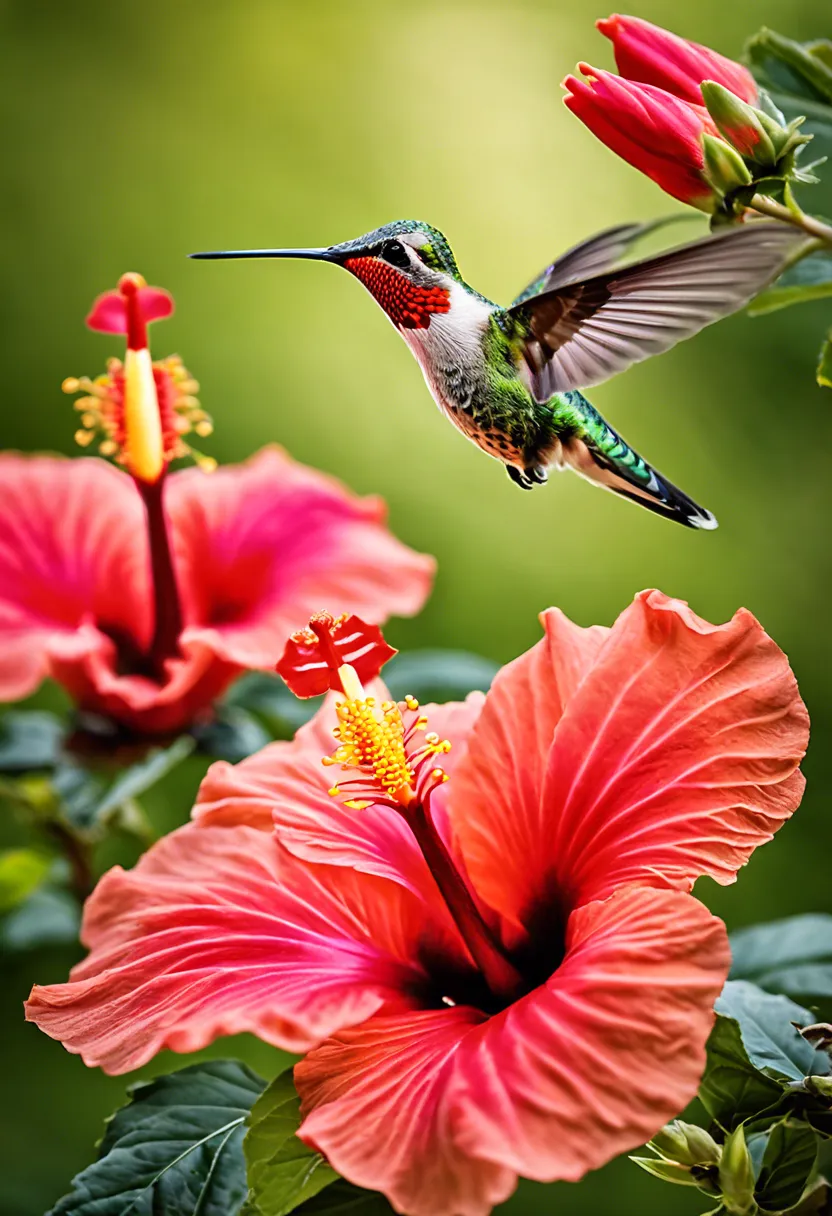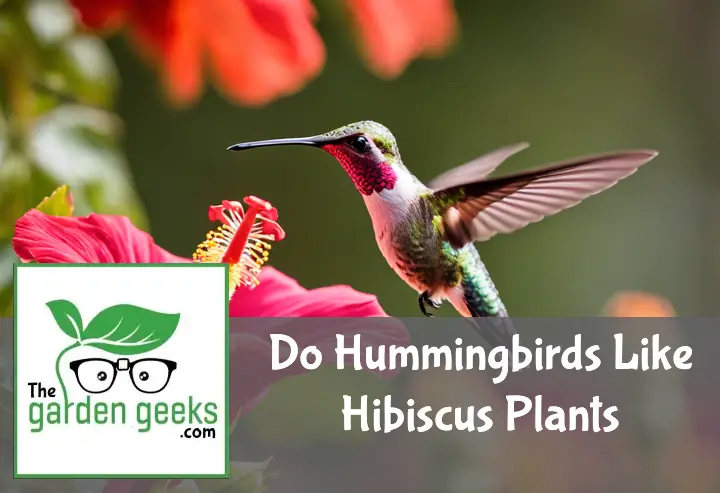Did you know that there are over 200 species of hibiscus worldwide? And guess who’s a big fan of these vibrant and nectar-rich flowers? Yes, hummingbirds! Do Hummingbirds Like Hibiscus Plants? The answer is a resounding yes.
Hummingbirds, with their iridescent feathers and rapid wing beats, are often seen hovering around hibiscus plants. These tiny birds are not just attracted to the beauty of the hibiscus but also its sweet nectar which provides them with much-needed energy.
So, if you’ve been wondering about creating a garden that attracts these fascinating creatures, keep reading about ‘Do Hummingbirds Like Hibiscus Plants’.
Quick Answer
- Yes, hummingbirds do like hibiscus plants. They are attracted to the bright colors and sweet nectar of the hibiscus.
- Hibiscus plants offer nutritional benefits to hummingbirds, providing them with essential energy.
- In return, hummingbirds assist in the pollination of hibiscus plants, promoting their health and growth.
- To attract hummingbirds, grow hibiscus in ideal conditions: warm climate, well-drained soil, and plenty of sunlight.
- Signs of healthy interaction include frequent hummingbird visits and thriving plant growth. However, attracting these birds can be challenging due to factors like competition and predators.

Do Hummingbirds Like Hibiscus Plants?
Hummingbirds and hibiscus plants share a special relationship. It’s like they’re made for each other, with the birds getting food and the flowers getting pollinated.
Attraction Factors: Why Hummingbirds are Drawn to Hibiscus
Hummingbirds can’t resist the bright colors of hibiscus flowers. These birds love anything that’s red or pink, and hibiscus plants often come in these shades. It’s like a big, flashing “Eat here!” sign for them.
Another big draw is the nectar production in hibiscus. These flowers make a sweet liquid that hummingbirds need for energy. They have to eat all day long, so finding a good nectar source is like striking gold.
The shape of hibiscus flowers also helps. They’re just right for hummingbirds to stick their long beaks into while they hover in mid-air. It’s like these flowers were designed with hummingbirds in mind.
Lastly, the location of hibiscus plants can play a role in attracting hummingbirds. If you put them where hummingbirds already like to hang out, you’ll see more of them coming around.
Nutritional Benefits: What Hibiscus Offers to Hummingbirds
The nectar composition of hibiscus is perfect for hummingbird diets. It gives them the sugar rush they need to keep zooming around from flower to flower.
But it’s not just about energy. The nectar from hibiscus flowers also has vitamins and minerals that help keep hummingbirds healthy. Think of it as their version of a multi-vitamin juice.
This nectar is especially important during migration when hummingbirds need all the help they can get to cover long distances. Finding a garden full of hibiscus can be a lifesaver for them.
So, yes, hummingbirds do like hibiscus plants—a lot! By planting these beautiful flowers, you’re not just making your garden look good; you’re also providing a vital resource for these amazing little birds.
How Do Hibiscus Plants Benefit From Hummingbirds?
Pollination Assistance Provided by Hummingbirds
Hummingbirds are like tiny, flying garden helpers for hibiscus plants. When they zoom in to sip nectar, their heads get dusted with pollen. Then, off they go to the next flower, taking the pollen with them. This is how they help with hummingbird pollination. It’s a big deal because without pollination, plants can’t make seeds or grow new plants.
This bird-assisted pollination is super important for hibiscus flowers. They need it to reproduce and spread their seeds around. Without hummingbirds doing their thing, we might have fewer hibiscus plants around. And that would be sad because they’re so pretty.
Impact on Plant Health and Growth
When hummingbirds visit hibiscus plants, it’s not just about getting food. Their visits actually help the plants grow better and healthier. Think of them as little flying doctors, giving the plants a check-up.
The good stuff includes better plant health improvement because the flowers get properly pollinated. This means more seeds and more baby plants growing up strong. Plus, the movement of hummingbirds can scare away smaller pests that might harm the plant.
But it’s not all sunshine and rainbows. Sometimes, if too many birds visit a single plant or if they’re a bit clumsy, they can damage delicate flowers or young shoots. However, these cases are rare compared to all the good stuff hummingbirds do for hibiscus plants.
So yeah, hummingbirds and hibiscus have this cool friendship going on. The birds get a tasty meal, and the plants get to grow up big and strong thanks to all that pollinating action.



Ideal Conditions for Growing Hibiscus to Attract Hummingbirds


Creating a garden that hummingbirds love starts with knowing the ideal growing conditions for their favorite plants. Let’s dive into what makes hibiscus irresistible to these tiny birds.
Climate and Soil Requirements
Hibiscus plants thrive in warm climates. They love the sun and do best in temperatures that don’t dip below 50°F. If you’re in a cooler area, don’t worry! You can grow hibiscus in pots and bring them inside when it gets chilly.
The perfect soil for hibiscus is slightly acidic, with a pH between 6.0 and 7.0. This type of soil helps the roots take up nutrients better, making your plants healthier and more attractive to hummingbirds.
Good drainage is key for hibiscus. They hate having wet feet! Make sure your soil isn’t too heavy or clay-like. Adding organic matter can help improve drainage and keep your plants happy.
Remember, the happier your hibiscus, the more likely it is to attract those delightful hummingbirds. So, paying attention to climate and soil type can make all the difference in creating a buzzing garden oasis.
Sunlight and Watering Needs
Hibiscus plants are sun worshippers—they need at least six hours of direct sunlight each day. The right amount of sun helps them produce those big, beautiful flowers that hummingbirds can’t resist.
But it’s not just about sunlight; how you water your hibiscus also matters. These plants like their soil to be consistently moist but not soggy. Think of it as giving them a steady sip, not a drowning flood.
During hot spells, you might need to water your hibiscus every day to keep up with their thirst. But be careful not to overdo it—too much water can lead to root rot.
Proper watering practices encourage lush growth and vibrant blooms, making your garden an inviting spot for hummingbirds. By balancing sunlight and moisture levels, you’ll have a thriving hibiscus haven that’s buzzing with life.
Signs of Healthy Interaction Between Hummingbirds and Hibiscus Plants
| Sign | Description |
|---|---|
| Frequent Visits | If hummingbirds are frequently visiting the hibiscus plants in your garden, it’s a good sign they like them. |
| Pollen Transfer | You may notice pollen on the beaks and feathers of hummingbirds, indicating they have been interacting with the hibiscus flowers. |
| Nesting Nearby | If hummingbirds build their nests near your hibiscus plants, it’s likely because they want to stay close to a food source they enjoy. |
| Aggressive Behavior | Hummingbirds can become territorial over food sources they particularly like. If you see them chasing other birds away from your hibiscus plants, it’s a sign they value them highly. |
| Long Feeding Times | If hummingbirds spend a long time feeding at your hibiscus flowers compared to other plants, it indicates that they prefer the nectar of the hibiscus. |
| Return Visits | Hummingbirds tend to return to food sources that they find appealing. If you see the same birds coming back to your hibiscus plants day after day, it’s a strong indication that they like these plants. |
Common Challenges in Attracting Hummingbirds with Hibiscus Plants
Attracting hummingbirds to your garden using hibiscus plants sounds like a piece of cake, right? Well, not always. Sometimes, even when you think you’ve done everything right, those little buzzing beauties just don’t seem interested. Let’s dive into some common roadblocks that might be keeping these feathered friends away from your hibiscus.
-
Wrong hibiscus variety: Not all hibiscus flowers are created equal in the eyes of a hummingbird. Some varieties might look pretty to us but don’t offer what hummingbirds are looking for. They prefer varieties with bright, open flowers that make it easy to dip their beaks in for nectar.
-
Lack of consistent blooms: Hummingbirds need a steady food source. If your hibiscus plants bloom sporadically or only at certain times of the year, hummingbirds might pass them by for more reliable food sources. Keeping your plants healthy and blooming consistently can be a challenge but is key to attracting these birds.
-
Pesticide use: If you’re spraying your hibiscus with pesticides, you might as well hang a “Keep Out” sign for hummingbirds. These chemicals can harm or even kill the tiny insects that hummingbirds feed on alongside nectar, making your garden less appealing.
-
Poor placement: Just like us, hummingbirds have preferences when it comes to dining locations. Placing hibiscus plants in areas that are too windy, too sunny, or too out of the way can deter visits from these birds. They prefer spots where they feel safe and can quickly escape predators.
-
Competition from other feeders: If your neighborhood is full of bird feeders offering high-quality nectar substitutes, your hibiscus might not be as attractive to hummingbirds. It’s tough competition out there!
-
Not enough cover: Hummingbirds like to zip in and out of danger spots quickly. If there aren’t enough trees or shrubs near your hibiscus plants for them to hide in or dart back and forth from, they might not feel safe visiting.
Understanding these challenges is the first step toward making your garden a hummingbird paradise. With some tweaks and patience, you’ll hopefully see more of these delightful visitors flitting around your hibiscus soon!
To Wrap Up
So, do hummingbirds like hibiscus plants? You bet they do! These tiny fliers are absolutely crazy for the nectar from these vibrant flowers.
If you’re keen on turning your garden into a hummingbird haven, planting hibiscus is a great start. Not only will you be helping our feathered friends, but you’ll also add a splash of color to your yard.
For more tips on attracting hummingbirds, check out Do Hummingbirds Like Hibiscus Plants. Let’s make our gardens hum with life!


FAQs about ‘Do Hummingbirds Like Hibiscus Plants?’.
What other plants attract hummingbirds besides hibiscus?
Hummingbirds are also attracted to flowering plants like bee balm, cardinal flower, trumpet vine, and salvia. These plants offer abundant nectar which is a primary food source for hummingbirds.
Can I use feeders to attract hummingbirds to my hibiscus plants?
Yes, you can use feeders filled with sugar water as an additional attraction. However, ensure the feeder is clean and the sugar solution is changed regularly to prevent fermentation.
Are certain types of hibiscus more attractive to hummingbirds?
While all hibiscus plants can attract hummingbirds, those with bright red or orange flowers tend to be more appealing due to their high visibility and ample nectar production.
How can I create a garden that’s friendly for both hibiscus and hummingbirds?
Creating a bird-friendly garden involves providing food sources (like hibiscus), clean water for drinking and bathing, safe nesting sites, and avoiding the use of harmful pesticides.
Do all species of hummingbird like hibiscus?
Most species of hummingbird are attracted to hibiscus due to its vibrant colors and rich nectar. However, preferences may vary slightly by region and individual bird behavior.
Does the color of the hibiscus flower matter in attracting hummingbirds?
Yes, hummingbirds are particularly attracted to brightly colored flowers. Red is often cited as their favorite color but they’re also drawn to pink, orange, yellow and purple blossoms.
Is there a specific time when hummingbirds visit hibiscus plants?
Hummingbirds typically feed throughout the day but are most active during early morning and late afternoon hours. They might visit your hibiscus during these times if it’s blooming.


